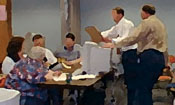

Chapter 19 - Authentic Assessment and Formative Program Evaluation
The best program evaluation provides rapid and frequent feedback to the innovators so that adjustments can be made while the program is underway. Unfortunately, much educational research has emphasized summative evaluation, assessments near the end of a project which indicate whether or not the project met its goals. Research which helps the participants change direction and steer the program more wisely, formative evaluation, is rare, and yet this is likely to be the kind of research most helpful to a school council and a group of innovators. Teachers can learn from day to day what is working and what needs changing.Another important source of insight is qualitative research which takes the perspectives of anthropology and looks at information such as interviews, journals and observations to make judgements rather than relying upon quantitative research which relies upon numerical measures. The tools associated with qualitative research are more accessible to school practitioners than are the statistical models associated with quantitative research.
Authentic assessment as used by the Coalition of Essential Schools refers to student activities which can demonstrate learning other than the traditional exams and standardized tests. The real issue with authentic assessment is whether or not the student can demonstrate a good grasp of the material being studied by providing some kind of performance or portfolio at the end of a unit which requires personal translation of key ideas. On Bloom's Taxonomy it would be the skill of synthesis, the invention of a new version of something. The student is informed at the commencement of a unit as to what kind of performance will be required by the end of the unit and then much of the unit is devoted to learning what will support the final performance.
If properly initiated, authentic assessment should bring the student's learning out into the open where the teacher can see what is going on within the student's mind. Authentic assessment gives the teacher useful data on a daily basis, information which will suggest changes in teaching strategy or modifications to the school innvation.
Writing for learning and thinking is a technique which is admirably suited to the support of innovation because it periodically asks students to write what is on their minds -- often for no more than 5 minutes. The teacher may circulate around the room scanning the papers to see who is on track and who is lost. This information, which all too often escapes the notice of teachers, provides the basis for revising the instructional strategy to reach a broader group of students than might have been otherwise possible.
Site-based management asks that teachers re-write the old scripts. Instead of relying upon patterns that have worked in the past, they are inventing new versions based upon what they can learn from their students. Authentic assessment shortens the time frame between data collection and data analysis so that teachers may be more closely involved in the analytical process. Formative assessment brings the classroom practitioner and the school council into the evaluation process much earlier and in more powerful ways than would be possible with traditional quanititave evaluations. If site-based management's success depend upon the insights of those closest to the client, then considerable attention must be devoted to the question of how to support the growth of such insight through the development of non-traditional assessment skills.
Copyrighted 1991 by Jamie McKenzie, all rights reserved.